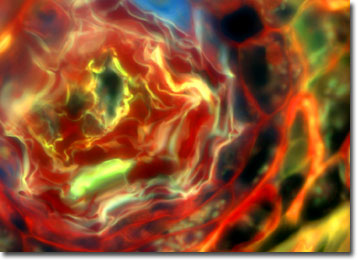Fluorescence Digital Image Gallery
Mycorrhizal Fungus
Most plant species are better able to utilize the soil in which they are growing with the help of beneficial microorganisms called mycorrhizal fungi. These fungi live in symbiosis with plants, growing on the surface of their roots (ectotrophic) or actually invading the hosts' roots (endotrophic).

The fine threads that make up the mycorrhizal fungus permeate soil particles, grow into decomposing organic matter, and even explore the shells of dead insects where they find phosphorus and other vital nutrients. The nutrients absorbed by the fungi are then passed back into the roots of the plants providing a major benefit to the plant--improved uptake of soil phosphorus. With better phosphorus nutrition, mycorrhizal plants grow more quickly than those lacking mycorrhizal associations.
Mycorrhizal plants are often more drought tolerant and can resist many root diseases that might otherwise threaten them. Soil networked with mycorrhizal fungi has proved to be important in resisting weed invasion. The network builds soil structure, which helps hold the soil together and allows many seedlings to survive that might not otherwise, increasing plant diversity. A network of mycorrhizal fungi in the soil can be crucial in restoration, reclamation, and erosion control. Soils must often be inoculated with the appropriate mycorrhiza in order to accommodate the species and diversity of plants being planted.
The specimen presented here was imaged with a Nikon Eclipse E600 microscope operating with fluorite and/or apochromatic objectives and vertical illuminator equipped with a mercury arc lamp. Specimens were illuminated through Nikon dichromatic filter blocks containing interference filters and a dichroic mirror and imaged with standard epi-fluorescence techniques. Specific filters for the ectotrophic mycorrhizal fungus specimen were a UV-2E/C, B-2E/C, and a Y-2E/C. Photomicrographs were captured with an Optronics MagnaFire digital camera system coupled to the microscope with a lens-free C-mount adapter.
BACK TO THE FLUORESCENCE DIGITAL IMAGE GALLERY
